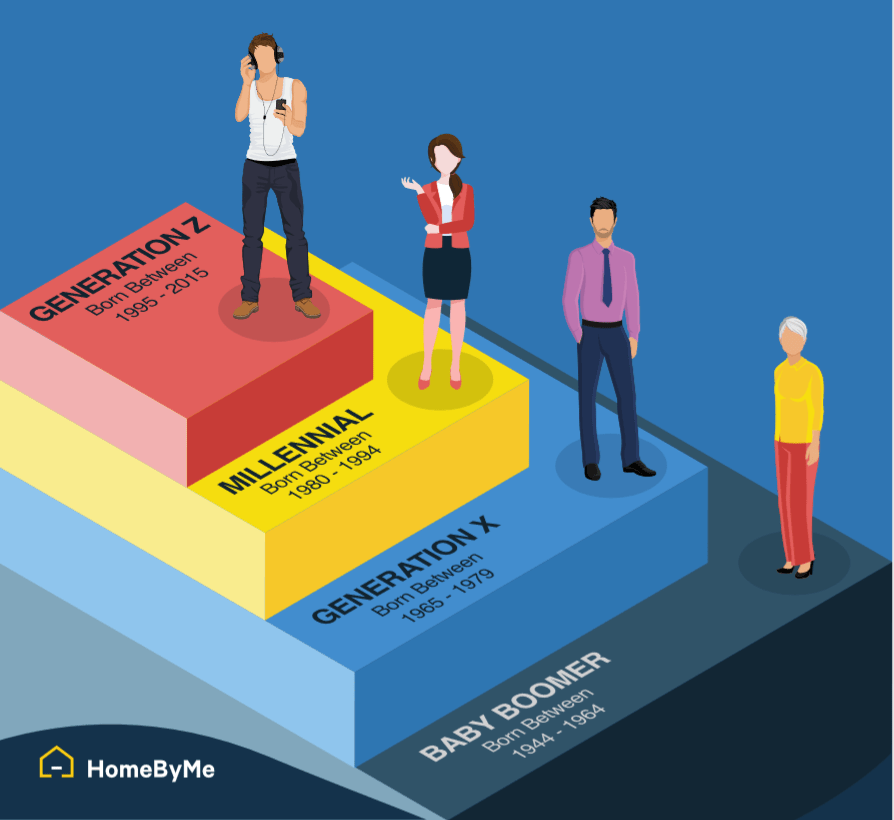From baby boomers to Gen Z: How to appeal to all demographics using the power of 3D planning solutions
Similar to the pace that design trends come and go within the realms of home improvement, the same can be said for buyer preferences and behaviors. Retailers are tasked with the seemingly impossible feat of appealing to and accommodating every shopper at all times, while constantly anticipating the next shift in the ‘shopper revolution’. The customer journey must hold universal appeal, with the flexibility to evolve as upcoming generations enter the market for the first time.
With a 3D planning solution, retailers can offer each customer – whether a baby boomer or millennial first-time buyer – an entirely personalized experience, both on their websites and in-store. Tailored product recommendations, and the ability to move furniture and fixtures within a like-for-like recreation of a customer’s home environment, resonate more effectively and increase the likelihood of that customer making a purchase.
However, in order to deliver a truly personalized experience retailers need information and insight, showing how demographics approach the journey slightly differently. There are certain trends and buying preferences for each age group that are important to understand. This will allow retailers to most effectively utilize 3D planning solutions alongside other tactics to achieve the widest appeal and deliver a personalized experience that meets the market demands.
A generation of homeowners
Following what was, at the time, an affordable housing market, baby boomer home ownership rates are reported to be as high as 80% in the US, accounting for 41% of all homeowners across the entire population. (Source: Econreview) Interestingly, this statistic does not necessarily translate into home improvement figures, with 56% undertaking new projects in the past year – almost 20% below Gen X and millennials.
Despite this, a study by Harvard University suggests baby boomers are a market for home retailers to watch closely. (Source: Harvard University) The research estimates that by 2025 they will make up a third of the home improvement market, with renovations in preparation to downgrade or retire. Upgrading outdated designs and focusing on adaptions for increased accessibility will be key.
In terms of shopping habits to look out for, a common misconception is that baby boomers are not as tech savvy as younger generations, as they actually favor online shopping over any other age category. For retailers looking to attract baby boomers, the availability of information is key. With access to extensive product listings and detailed information alongside realistic 3D renderings, an online 3D planning solution can equip the buyer with everything they might need to make a purchase.
The millennial home improvement enthusiast
Millennials are currently the largest demographic carrying out home improvements, equating to a reported 83.1 million potential shoppers. This makes the age category incredibly attractive to retailers, especially when it comes to first-time buyers entering the property market and keen to undertake large scale projects to personalize their new home.
With property prices at an all-time high, many millennials are faced with having to compromise on location, the number or rooms or the condition of the property. However, the aspiration to own remains strong with a high appetite for new and affordable homes. The rental market is also a popular choice as a cost-effective alternative, limiting higher spend home improvements but increasing the number of smaller projects that include furniture and furnishings that can inject personality.
When looking to undertake home improvements, millennials use a combination of devices, whether mobile, tablet or computer, but still place great value in the in-store experience. According to a retail report by Trendsource, millennials ranked home improvements as one of the top three industry verticals where shopping in-store is preferable to online. 88% of respondents said that was due to the immediacy of the in-store experience, while 62% said that they look for advice from sales associates.
In order to appeal to millennials and their diverse range of buying preferences, an omnichannel approach is crucial. A 3D planning solution allows for a smooth transition from online to offline and vice versa, with cross-device user accounts giving access anytime and anywhere. Whether in-store or online, the customer can pick up the phone or check in at any stage of the buying process, pick up exactly where they left off and receive personalized advice from sales staff.
Paving the way for Gen Z
Often referred to as the ‘digital natives’, Generation Z have grown up using the internet, with smartphones and social media use particularly prevalent. According to Bluecore, by 2020 85% of Gen Z will research new products on social media, adding weight to the rising trend for social shopping. Channels such as Instagram or Pinterest are great sources of inspiration for this demographic and a way to share and validate design ideas with peers.
To best reach Gen Z shoppers, retailers can utilize 3D planning solutions to generate high quality renderings that are easy to download and share on social media. This in turn increases brand visibility through social engagement, attracting new shoppers and building on brand advocacy.

Using 3D planning for transcendent customer experiences
With a rising number of shoppers across all age groups choosing to carry out web research before they even consider engaging in-store, becoming that relevant source of information is key for the home retailer to drive footfall and accelerate the sales cycle. Using the HomeByMe Furniture & Decor Planner, retailers can reclaim the research phase under their terms, providing anytime access to live catalogs and custom visual representations of a customer’s design ideas.
But perhaps the main benefit for retailers is the user data generated by customer profiles, providing invaluable insight into exactly what products customers are looking at and the design ideas that are trending across demographics. This can be used to inform targeted marketing campaigns, merchandising, future purchasing decisions and more. With a 3D planning solution, retailers can monitor and react to customer behavior to stay ahead of the curve – steering customer demand, no longer just adapting to it.
For more information on how a 3D planning solution can help appeal to customers across all demographics and deliver excellent omnichannel customer experiences, visit our website built specifically to serve home retailers where you can organize a demonstration of the platform with a member of our team of experts.
